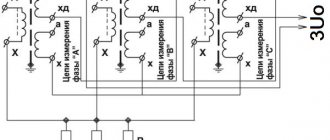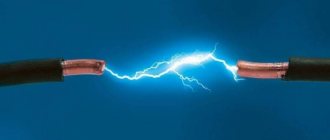Step voltage is the potential difference in the area of the earth where current flows, with a distance between points equal to a standard human step, that is, 0.8–1 m . The value of this indicator depends on the physical properties of the soil (resistivity), frequency and strength of the current spreading over the area, and a number of other parameters.
Those under its influence feel tingling in the legs, and in severe cases, cramps appear. In panicked attempts to leave the emergency zone, an unprepared person tries to run away, and quickly with the maximum possible stride length. In many cases this causes death.
Due to the effect of electric current dissipation, the risk of injury from step voltage decreases with distance from the point of contact of the emergency wire with the ground. At a distance of 20 m under normal conditions, the probability of receiving an electric shock tends to zero.
Reasons for its appearance
In the immediate vicinity of high-voltage power lines, in areas with cable communications, there is a danger of the occurrence of such a phenomenon as step voltage. A similar effect occurs under various circumstances. For example, the cause of the appearance may be a power line break, in which one of the conductors fell to the ground. In addition, the zones located around the standard grounding conductors of electrical equipment also pose a danger in emergency situations with a short circuit to ground.
There is a possibility of step voltage occurring when the insulation of high-voltage underground cables breaks down when automatic protective devices that are supposed to de-energize the line in emergency situations fail.
For this reason, it is not recommended to stay in areas where power lines and underground utilities are located, especially in conditions of high humidity, and even more so during rain.
Why does SN occur?
This phenomenon usually appears when the cable supplying electricity to a certain system breaks. Wires are often laid underground, and energy begins to “leak” into it. The most dangerous situations are when this happens in damp places, such as ponds or swamps. Wet asphalt is no less dangerous, because water conducts electricity well in any case. In addition, ShN can appear not only on the street, but also in enclosed spaces.
ShN also occurs in other cases:
- with changes in atmospheric pressure;
- after a short circuit in electrical circuits;
- after explosions at electrical substations.
There are known cases of its occurrence even after lightning strikes into the ground.
Types of step voltage
The most dangerous is the step voltage that occurs with a single ground electrode. This case can be compared to the situation with a power line falling to the ground. In this case, the maximum potential will be precisely at the point of contact with the surface or at the installation site of the ground electrode.
Also read: What is a surge suppressor (SPD)
Due to the dissipation of current along the ground, with increasing distance from the grounding point, the potential value decreases, and the value changes along a curved curve, with a maximum decrease precisely in its first section. Therefore, the most dangerous step is considered to be one in which one foot is located directly on the wire or above the ground electrode, and the second at a distance of 0.8–1 m. Being at a distance of up to 8 m at a voltage of no more than 1 kV is considered potentially dangerous, and for high-voltage networks this the indicator decreases to 4-5 m.
A similar picture is observed in the presence of group grounding conductors, with the only difference being that the total potential is distributed over all grounding conductors. That is, the total step voltage (potential difference) at a distance of one human step will be less. And when your feet are on different grounding conductors, no consequences will be felt, since they have the same potential value.
Step Voltage Values
From the physical prerequisites for the occurrence of such an effect, it becomes clear that the magnitude of the step voltage depends on the distance from the ground electrode or fallen wire, and the distance between the feet.
In this case, the following main values can be distinguished:
- Maximum - occurs in cases where one foot is on the wire or on the ground above the grounding electrode, and the second at a distance of 80–100 cm. This is explained by the steepness of the drop in the curve of the potential versus the distance to the grounding point. It is in this area that the potential difference will be maximum.
- The minimum value is possible only at a significant distance from the point of contact of the wire with the ground. In this zone, the dissipation of electric current is no longer observed, so a potential difference does not arise at any step size.
- A zero value is typical for those situations when the feet are on points characterized by identical potentials. This becomes possible if you stand on the elements of a group grounding electrode or keep your feet almost close.
It is on these data that the rules for exiting the step voltage zone that occurs in an emergency are justified. Practice has shown that these recommendations should be followed until the distance to the center of the zone exceeds 20 m.
Also read: How many watts are in one kilowatt
Physics and physiology
Step voltage is the potential difference between two sections of soil. When lightning strikes, current “spreads” into the soil, creating an area of high potential. If there are conductors nearby, a circuit can form. A person can become such a conductor: the current enters through one leg and exits through the other, turning the body into a “load”. This situation is extremely dangerous, since high voltage causes muscle paralysis, like from a stun gun. As a result, a person may fall on his hands, and, with multi-component lightning, the current of subsequent discharges will go through the heart, increasing the risk of cardiac arrest. If your head touches the ground, the risk of irreversible damage to the central nervous system increases dramatically.
It will be interesting➡ Electric circuit and its elements
The right side of the figure schematically shows the effect of step voltage, which creates a load through the legs (red arrow) - that's why it got the name step voltage. Conventional lightning can carry tens of thousands of amperes of current (I1-2), resulting in a potential difference (V1-V2) that can exceed tens of thousands of volts. Since there is a voltage difference between two points (legs), the human body represents a complex electrical resistance and acts as a load. The amount of current (Ib) passing through the body in this case depends on the resistance of the foot (Rf) and body (Rb).
Step Voltage Hazard
The problem is that the impact of lightning pulse current on living organisms has been poorly studied. It is possible to calculate the approximate value of current and step voltage, but the result of their interaction with the human body is less predictable. Lightning strikes, including those with step voltage, have unique “physiological features.” First of all, this is due to the fact that although lightning carries a huge amount of energy, it is released in a very short period of time: 1/10000-1/1000 of a second. Such shocks rarely cause severe burns or damage to internal organs, as is the case with electric shocks from conventional electrical equipment. But lightning can affect the heart and nervous system, including peripheral nerves.
Therefore, the consequences of a step voltage shock can be unexpectedly significant and very diverse: from cataracts, paralysis of the limbs and chronic pain to sleep and mental disturbances, hearing loss, memory loss, etc. The most common cause of death is cardiac arrest.
In his webinars for designers of lightning protection systems, Doctor of Technical Sciences, Professor Eduard Meerovich Bazelyan has repeatedly noted the lack of a clear definition of the dangerous value of step voltage. Thus, it is known that the pulsed impact of 6 kV lightning can cause cardiac fibrillation and possible cardiac arrest. But the physiology of the human body is complex, and even less exposure can cause severe injury and lead to death. In the case of pacemakers and other channels of direct current access to the heart muscle, a short-term exposure of 1 mA is sometimes sufficient to cause fibrillation.
At the same time, the high resistance of dry skin is not reliable protection. With step voltage it is even more difficult, since the current usually flows through the limbs, and joints have higher resistance than blood vessels and muscles. Because of this, tissues near the joints can become very damaged, leading to disability. A striking illustration of the formidable power of step voltage was the case of mass death of deer in Norway during a thunderstorm. The lightning strike killed 323 wild deer in an area of approximately 50 meters.
Interesting read: what are capacitors?
Movements in the step voltage zone
The main task is to place your feet so that there is the minimum possible potential difference between the points of contact with the ground. In this case, no consequences for the body are observed except for an unpleasant tingling sensation.
Since a person cannot change the magnitude of the potentials, and staying in place is also not an option, because it is unknown whether the protective automation will work or not, a safe exit is possible only with a maximum reduction in the step size. Therefore, it is recommended to leave the affected area with a goose step. This method involves the following steps:
- Do not lift your feet from the surface of the ground, move your feet, dragging along the ground.
- For each step, move your foot so that the heel of one is level with the toe of the other (Fig.b).
- Making these steps even smaller may increase exit time, but will reduce the risk of electric shock.
It is not recommended to jump on one leg, although such advice can be heard. If we consider the situation from the point of view of the potential difference, then this option is good. But do not forget about the danger of tripping or falling into a hummock or hole, because there are no ideal conditions in the field. As a result of such incidents, it will be difficult to stay on your feet, and if you fall, the potential difference will increase, since the distance between the points will be equal to the person’s height. It is these falls that cause the majority of deaths. Take your time, move at a goose pace.
First aid for electric shock
Always think about your own safety!
- First aid must be started immediately. The first step is to free the victim from the effects of electric current.
- Then immediately call an ambulance!
- If there is no breathing or heartbeat, begin artificial respiration and cardiac massage.
- If possible, apply a sterile dressing to the electrical burn site.
- Provide peace to the victim.
The victim, regardless of his health, should be sent to a medical facility.
What should not be done with the victim and why:
- Bury in the ground (breathing will be difficult, which will affect the functioning of the heart)
- Pour water over it (cools the body)
- Contaminate the surface of the burn (tetanus or gangrene begins to develop)
Leaving the step voltage zone
To increase your chances of rescue, if you get into the range of step voltage, proceed according to the following scheme:
- If you are close to power lines, operating transformer substations, or other electrical equipment, stop if you experience a tingling sensation in your legs or cramps.
- Do not attempt a stampede, this is the main mistake that can be made.
- Look around, determine the possible location of the wire falling and the short circuit to the ground. Even if there are no visible landmarks, choose a direction to move away from any electrical lines or equipment.
- Go out in a goose-step, the minimum distance traveled should be at least 20 m, it is better to be on the safe side.
Also read: How to determine phase and zero with and without instruments
After leaving the danger zone, immediately notify the rescue service, since you most likely will not have the telephone number of the energy supply organization at hand. Do not take any action to eliminate the accident yourself, especially if you do not have access to devices that allow you to turn off the power to individual sections of the network or de-energize electrical equipment.
Horse accident
In 1928, an accident occurred in Leningrad, which was included in textbooks under the name “horse accident”.
In the middle of the square, paved with wooden hexagons, stood a cast-iron well with a 2000-volt disconnector. One day, the insulator cracked in the well, and the disconnector hung on the wire a few centimeters from the wall. The rain fell and the pavement became conductive and pliable. When a loaded cart passed next to the well, the pavement bent and the wire was shorted to the well.
People whose step length did not exceed a meter were simply shocked. And the horse, with its one and a half meter body and iron horseshoes, was killed to death. The pavement was energized for two seconds, after which the “automatic machine” was activated at the substation.
The unexpected death of a horse aroused people's interest, and a mounted patrol arrived. The cart was pulled away and the short circuit stopped. At this time, the substation duty officer checked the insulation resistance and, considering the shutdown false, turned on the current. The disconnector with the well formed an electric arc, and step voltage arose on the pavement again, killing two police horses.
The duty officer did not have the right to re-apply the current, so the damage was limited to three killed horses.
In 2011, a similar accident occurred at an English racecourse in Berkshire, the cause was a dilapidated underground cable. The slaughtered horses wore steel shoes, but those shod with aluminum survived.
How to free a person
Any action can be taken only in cases where there is a threat to the life of another person. And then, only when you clearly know what to do and are confident in your abilities. If an accident occurs in the area of operation of lines up to 1 kV, proceed according to the following scheme:
- They move towards the victim in a “goose step”.
- To remove the wire from it, use a pre-prepared dry wooden pole.
- They evacuate the victim, having previously wrapped their hands in dry clothes, which will act as an insulator.
If the accident occurred on a high-voltage line, then rescue is possible only with PPE (insulator gloves, galoshes) or after the line is disconnected. You can speed up the process by short-circuiting the phases by throwing a branch or wire over them. If this is not possible, do not try to take risks, it is life-threatening. Entry into the possible affected area without personal protective equipment is prohibited. The best help is calling rescuers.
Methods for reducing step voltage in enterprises
Industrial enterprises use a simple method that has proven effective in practice. To do this, it is necessary to equalize the potentials in the area of possible dissipation of electric current. To do this, group grounding switches are installed, made in the form of a grid with a small cell size. At all points the potential will be the same, so even with emergency short circuits to ground, the effect of step voltage will not occur.
A similar protection scheme is used in places where open switchgears, transformer substations, powerful electrical equipment and electrical machines are installed. It should be understood that it is impossible to provide such protection along the entire length of existing power lines around each support; it is too expensive. Therefore, when you detect the first signs (pinching, shaking), leave the danger zone, moving in a “goose step” without lifting your feet.
Means of protection
To avoid emergency situations associated with high voltage breakdown in places where people are, protective equipment for both individual and general purposes is used. Necessary individual items to protect against the hazardous effects of electricity include:
- special overalls;
- gloves;
- dielectric shoes;
- plastic helmets.
Protection against step voltage of a general nature is a means of emergency automation. Modern automatic control systems instantly react to a power leak and disconnect the line where it occurred.











